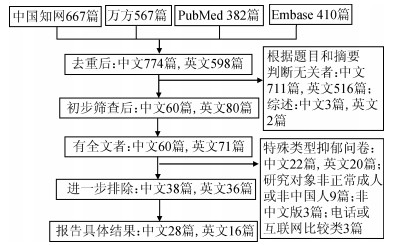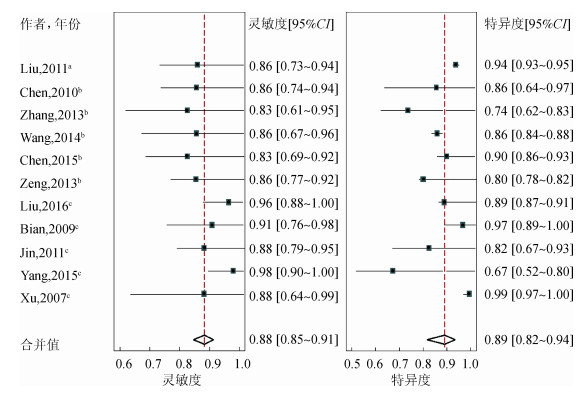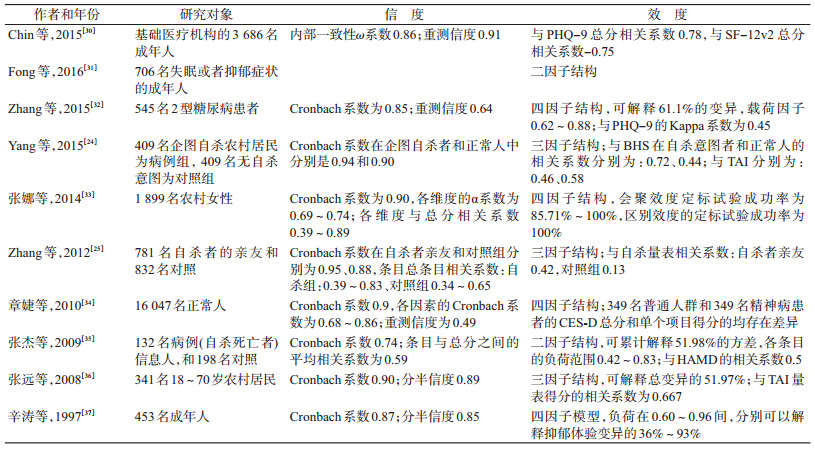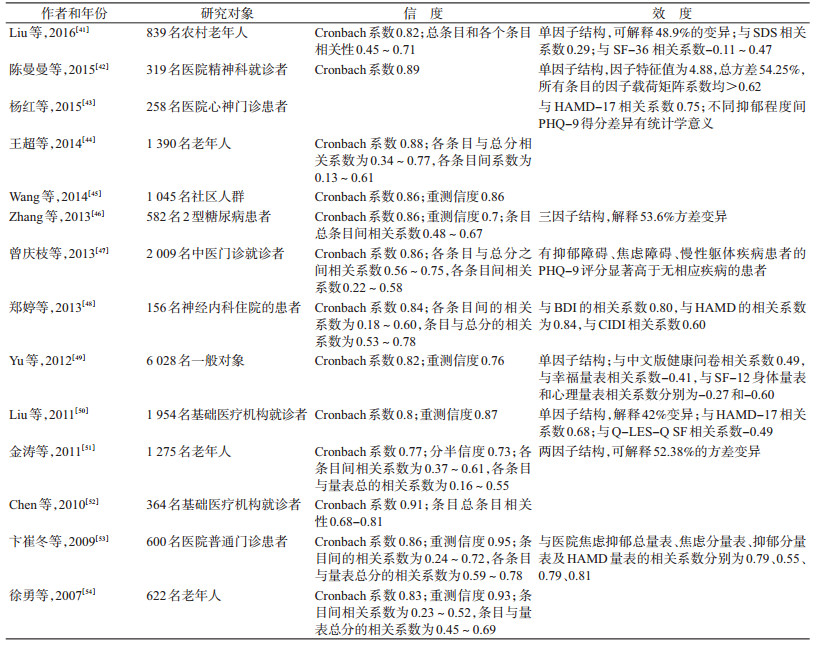文章信息
- 孙晓艳, 李怡雪, 余灿清, 李立明 .
- Sun Xiaoyan, Li Yixue, Yu Canqing, Li Liming .
- 中文版抑郁量表信效度研究的系统综述
- Reliability and validity of depression scales of Chinese version: a systematic review
- 中华流行病学杂志, 2017, 38(1): 110-116
- Chinese journal of Epidemiology, 2017, 38(1): 110-116
- http://dx.doi.org/10.3760/cma.j.issn.0254-6450.2017.01.021
-
文章历史
收稿日期: 2016-08-16
2. 100191 北京大学公共卫生学院劳动卫生与环境卫生学系
2. Department of Occupational and Environmental Health, School of Public Health, Peking University, Beijing 100191, China
抑郁是最常见的精神类疾病,在致伤残原因中居第四位,是导致非致死性疾病负担的最重要因素[1],每年给全世界造成严重的经济负担。据估计到2020年,抑郁将成为全球范围内发病率和死亡率居第二位的疾病[2]。因此,选择信效度较高的抑郁量表以实现抑郁的早期发现,这一工作至关重要。
国内常用的中文版抑郁量表有贝克抑郁量表(Beck Depression Inventory,BDI)、汉密顿抑郁量表(Hamilton Depression Scale,HAMD)、流调中心抑郁量表(Center for Epidemiological Studies Depression Scale,CES-D)、患者健康问卷抑郁量表(Patient Health Questionnaire Depression Module,PHQ)及老年抑郁量表(Geriatric Depression Scale,GDS)等,研究者运用这些量表对人群抑郁患病情况及抗抑郁治疗的效果开展了大量的研究[3-4]。也有研究者对这些量表进行了信效度的分析。本文在前人对量表信效度评价的基础上对以上几种中文版量表的信效度进行综述,了解现阶段中文版抑郁量表的质量并评价量表的筛查指标(PHQ-9),有助于公共卫生学研究以及抑郁的二级预防和疾病负担的减轻。
资料与方法1.文献检索策略:检索万方、中国知网、PubMed和Embase数据库。中文检索词主要包括“抑郁”并且“信度”或者“效度”,英文检索词主要包括depress* AND reliability OR validity AND China OR Chinese。
2.文献纳入标准:截至2016年5月6日检索出的满足下列条件的文献:①使用中文版抑郁量表;②报告了量表的信度或效度;③研究对象为中国成年人。排除标准:①综述等非原创性研究;②脑卒中抑郁、产后抑郁等特殊类型抑郁量表;③研究对象为痴呆、精神分裂患者或非中国人;④与互联网、电话访谈进行的比较性研究。
3.诊断试验准确性(diagnostic test accuracy,DTA)的Meta分析:本文对纳入文献中报告了灵敏度和特异度的PHQ-9量表进行了DTA Meta分析。首先由两名评价者按照QUADAS2标准对纳入的文献进行质量评价、数据提取并交叉核对,意见不一致时协商解决或参考第三方意见。将原始数据进行整理,采用Cochrane推荐的HSROC模型用于评价诊断试验的筛查能力[5]。HSROC模型为随机效应模型,适用于各原始研究诊断阈值不同时的分析,该模型是对固定效应ROC模型的扩展,拟合两水平混合logistic回归模型,在各研究内对其灵敏度和特异度采用logit变换,使其呈双变量正态分布,同时假定各研究间由阈值和准确性的差异导致的随机效应是独立且呈正态分布的,HSROC模型在此假设下计算相应参数进行分析[6]。本文运用该模型对应的metandi语句在Stata 12.0中完成数据分析。
结果本研究共检索文献1 372篇,根据研究纳入标准最终有合格文献44篇,具体筛选流程见图 1。纳入文献中,以CES-D和PHQ的信效度研究最多,分别有14篇和16篇,HAMD和BDI量表研究数目相对较少。总的来说,抑郁量表信效度的评估有明显的时间分布特点。最初抑郁量表多应用于临床研究中评估抑郁状态或严重程度,例如HAMD和BDI。随着流行病学的发展,更多的研究者着眼于适用于流行病学调查研究的PHQ、CES-D等量表。本文按照抑郁量表的时间顺序将主要抑郁量表的信效度评估结果进行综述。

|
| 图 1 文献检索和纳入排除流程图 |
1. HAMD:HAMD由Hamilton于1960年编制,是临床最常用的量表之一,可用于抑郁障碍的诊断以及严重程度、抗抑郁药物治疗效果的评定,许多抑郁量表的编制及效度的研究均以其作为参照[7-9]。该量表主要包括认识障碍、睡眠障碍、焦虑/躯体化、体重变化、绝望感等维度,用于评价研究对象当时或最近一周的情况,并根据总分判断研究对象的抑郁状态。在我国HAMD较多用于临床医生对患者抑郁的评价。
目前对中文版HAMD信效度评价的文章不多,20世纪90年代的研究表明HAMD-17量表Cronbach系数>0.7,内部一致性较好,量表的聚合效度、效标效度和区分效度均可,但研究者对量表结构效度的评价不一[10-11]。对HAMD-6的评价显示量表项目间平均相关系数为0.131,重测信度为0.95[12],说明量表内部一致性和稳定性较好。
2. BDI:BDI由美国学者Beck于1961年编制,是最早的抑郁自评量表之一,可用于抑郁的临床诊断和调查研究[13],为后来抑郁量表的编制奠定基础。该量表由21个条目组成,研究对象结合近一周的情况对每个条目进行自我评价,总分越高说明抑郁程度越严重[14]。随后出现了13条目的简版[15]和结合DSM-Ⅳ制订的BDI-Ⅱ[16]。BDI在我国多用于临床患者抑郁状态的评估。
目前对BDI进行的研究表明量表的Cronbach系数均大于0.85[17-19],分半信度为0.88[18],内部一致性较好。量表为四因子结构,与HAMD相关系数均>0.6,且能够对正常组、抑郁组和其他神经症状组进行区分,聚合效度和区分效度良好[18-19]。BDI-13量表的Cronbach系数为0.71[20],且为四因子结构。BDI-Ⅱ量表的Cronbach系数为0.94,重测信度为0.55,量表内部一致性较好,但稳定性不足。结构效度分析为二因子结构[21]。目前对BDI-Ⅱ和BDI-13效度的分析仍不全面。
3. CES-D:CES-D由美国国立精神卫生研究院的Radolff于1977年编制,目前广泛用于抑郁症状的初步筛查。其编制借鉴了BDI、抑郁自评量表(SDS)和明尼苏达多项人格测验抑郁量表[22]。但与BDI和SDS不同,CES-D不能用于临床目的及治疗过程中严重程度变化的监测,仅适用于流行病学调查。CES-D共20个条目,在应用中有人发现,CES-D20存在作答时间过长、被试情绪负荷较高及项目内容敏感等问题,因此多种简版量表如CES-D10、CES-D13相继出现[23]。在我国,CES-D及其简版广泛应用于社区、农村等人群中抑郁状况的评价。
现阶段对CES-D20信效度的研究较多,结果显示其内部一致性、可靠性和稳定性较高,信度较好且在自杀高危人群[24-25]中更优(表 1)。以不同量表HAMD、考试焦虑量(TAI)、贝克绝望量表(BHS)为效标,与PHQ-9、生活质量量表(SF)等对比时发现量表的效标效度、聚合效度、区分效度均较好。除此之外,研究者在大样本人群中对CES-D9、CES-D10、CES-D13的信效度进行评估,发现简版量表的Cronbach系数均>0.8,且删减后量表与原量表的相关系数>0.95,与原量表相容效度高,研究同时显示简版量表的聚合效度和区分效度较好[26-29]。不同版本CES-D量表信效度均较高,考虑到研究对象依从性、研究结果的准确性及调查成本等,针对一般人群的研究中可选择简版进行评估。但目前对简版问卷的评估仍存在研究对象较局限、效度评价不全面及未能评价其筛查效度等问题。
4. PHQ-9:PHQ-9由Robort Spitzer教授于20世纪90年代编制,由《基层医疗精神疾病评估工具》衍生而来,是临床抑郁诊断和一般人群调查研究中常用筛查量表[38]。PHQ-9由9个条目组成,基于DSM-Ⅳ中重性抑郁障碍诊断的9条症状标准,通过询问研究对象在过去两周有多少时间会受到上述9个方面的困扰及发生的频率进行抑郁的评价。该问卷在使用中发展了不同的版本,如PHQ-2、PHQ-8、PHQ-15等。在我国,PHQ广泛应用于人群抑郁的判别和干预措施疗效的评价。
对现阶段中文版PHQ-9量表的信效度研究结果见表 2,可见PHQ-9内部一致性及稳定性较好,以HAMD-17、复合性国际诊断交谈表(CIDI)、BDI和医院焦虑抑郁量表等进行效标效度、聚合效度和区分效度的分析结果均较理想。研究者对PHQ简版的信效度评估结果发现量表的信效度均达到可适用条件[39-40],但整体低于PHQ-9,可能与量表条目过少导致的内部一致性和稳定性较低有关。
对纳入文献中提供了灵敏度和特异度指标的11篇原始文献进行诊断实验准确性的Meta分析,应用QUADAS2标准对其质量进行评价,提示存在偏倚的风险较低,具体评价结果见图 2。异质性检验的χ2检验结果P<0.001,提示各研究间存在异质性,由于各研究诊断阈值不同,故采用随机效应模型中的HSROC模型进行分析。原始文献灵敏度、特异度及合并后效应值见图 3。

|
| 图 2 中国成年人PHQ-9问卷原始文献质量评价 |

|
| 注:aSCAN(Schedule for clinical assessments in Neuropsychiatry),临床神经精神评估表;bMINI(Mini-International Neuropsychiatric Interview),简明国际神经精神访谈;cSCID(the Structured Clinical Interview for DSM-Ⅳ Axis),DSM-Ⅳ临床定式访谈 图 3 中国成年人PHQ-9问卷原始文献研究灵敏度和特异度 |
分析结果显示PHQ-9筛查效能较好,合并后灵敏度为0.88(95%CI:0.85~0.91),特异度为0.89(95%CI:0.82~0.94),诊断比值比DOR为62.6(95%CI:33.23~117.92)。结合HSROC模型分析,提示PHQ-9判别抑郁的能力较强(Lambda=5.18[1.66,8.71]),SROC曲线对称(β=1.42,P=0.229),作为筛查工具准确性较高。此外,漏斗图无明显不对称,未发现明显的发表偏倚(P=0.369)。PHQ-9是筛查抑郁的可靠工具。
5. GDS:GDS常用于老年人抑郁症状的初筛。该问卷由Yesavage等于1982年编制,由30个条目组成,要求受试者以“是”或“否”做答,总分得分越高抑郁越严重。GDS不包含食欲下降、睡眠障碍等在正常老年人中也常见的躯体症状,回答方式简单。因此,该量表在老年人群评价抑郁状况、分析影响因素以及评估干预疗法中应用较为广泛[55]。
目前研究表明GDS-30的Cronbach系数>0.85,重测信度>0.73,分半信度为0.83[56-59],内部一致性和稳定性较好。GDS与CES-D、生命质量量表[56]及社会支持评定量表[57]相关系数分别为0.79、-0.4和-0.46,且日常生活能力障碍组总分高于正常组,即区分效度和聚合效度良好。以CES-D为效标的相关系数>0.95[58],效标效度良好。
1986年Sheikh和Yesavage在GDS-30的基础上减少问卷条目,开发出简版GDS-15。由于该问卷更为简短,易于操作,在临床工作者和心理学研究者中应用广泛。但现有研究表明,该量表内部结构不佳,效度不理想[44, 60-61],整体信效度低于GDS-30。
综上所述,适用于不同人群的中文版抑郁量表的信效度均较高,进一步对PHQ-9量表进行Meta分析的结果也表明该量表灵敏度和特异度较高。但由于本研究纳入的原始文献中缺少对CES-D、GDS等量表灵敏度和特异度的分析结果,故未对这些量表的筛查性能进行评价。此外,现有研究中各量表的评价人群有限,未能获得同一量表在多种人群中的信效度结果,并且缺少对各量表较新版本的全面评价,后续的研究可以进行相关证据的补充。
利益冲突: 无
| [1] | üstün TB, Ayuso-Mateos JL, Chatterji S, et al. Global burden of depressive disorders in the year 2000[J]. Br J Psychiatry , 2004, 184(5) : 386–392. DOI:10.1192/bjp.184.5.386 |
| [2] | Murray CJ, Lopez AD. Alternative projections of mortality and disability by cause 1990-2020:global burden of disease study[J]. Lancet , 1997, 349(9064) : 1498–1504. DOI:10.1016/s0140-6736(96)07492-2 |
| [3] | Huang V, Peck K, Mallya S, et al. Subjective sleep quality as a possible mediator in the relationship between personality traits and depressive symptoms in middle-aged adults[J]. PLoS One , 2016, 11(6) : e0157238. DOI:10.1371/journal.pone.0157238 |
| [4] | Sienko RM, Saules KK, Carr MM. Internalized weight bias mediates the relationship between depressive symptoms and disordered eating behavior among women who think they are overweight[J]. Eat Behav , 2016, 22 : 141–144. DOI:10.1016/j.eatbeh.2016.06.002 |
| [5] | Macaskill P, Gatsonis C, Deeks JJ, et al.Chapter 10:analysing and presenting results[M]. , 2010: 1–61. |
| [6] |
张天嵩, 钟文昭, 李博.实用循证医学方法学[M]. 长沙: 中南大学出版社, 2014.
Zhang TS, Zhong WZ, Li B.Applied methodology for evidence-based medline[M].Changsha: Central South University Press, 2014. |
| [7] | Fava GA, Kellner R, Munari F, et al. The hamilton depression rating scale in normals and depressives[J]. Acta Psychiatr Scand , 1982, 66(1) : 26–32. DOI:10.1111/j.1600-0447.1982.tb00911.x |
| [8] | Williams JB. A structured interview guide for the hamilton depression rating scale[J]. Arch Gen Psychiatry , 1988, 45(8) : 742–747. DOI:10.1001/archpsyc.1988.01800320058007 |
| [9] | Bech P, Allerup P, Gram LF, et al. The Hamilton depression scale:evaluation of objectivity using logistic models[J]. Acta Psychiatr Scand , 1981, 63(3) : 290–299. DOI:10.1111/j.1600-0447.1981.tb00676.x |
| [10] |
赵靖平, 郑延平.
Hamilton抑郁量表的信度和效度[J]. 中国心理卫生杂志 , 1992, 6(5) : 214–216.
Zhao JP, Zheng YP. Reliability and validity of hamilton depression scaleassessed in 329 Chinese depression patients[J]. Chin Ment Health J , 1992, 6(5) : 214–216. |
| [11] |
张岱, 舒良, 沈渔村.
汉米尔顿抑郁量表在老年病人中应用的研究[J]. 中国临床心理学杂志 , 1993, 1(1) : 22–24.
Zhang D, Shu L, Shen YC. Application of hamilton depression scale depression in geriatric patients[J]. Chin J Clin Psychol , 1993, 1(1) : 22–24. DOI:10.16128/j.cnki.1005-3611.1993.01.006 |
| [12] |
李文波, 许明智, 高亚丽, 等.
汉密顿抑郁量表 6项版本(HAMD-6)的信度及效度研究[J]. 中国神经精神疾病杂志 , 2006, 32(2) : 117–120.
Li WB, Xu MZ, Gao YL, et al. The validity and reliability of the six-item hamilton depression rating scale[J]. Chin J Nerv Ment Dis , 2006, 32(2) : 117–120. DOI:10.3969/j.issn.1002-0152.2006.02.006 |
| [13] | McPherson A, Martin CR. A narrative review of the beck depression inventory (BDI) and implications for its use in an alcohol-dependent population[J]. J Psychiatr Ment Health Nurs , 2010, 17(1) : 19–30. DOI:10.1111/j.1365-2850.2009.01469.x |
| [14] | Beck AT, Ward CH, Mendelson M, et al. An inventory for measuring depression[J]. Arch Gen Psychiatry , 1961, 4 : 561–571. DOI:10.1001/archpsyc.1961.01710120031004 |
| [15] | Beck AT, Rial WY, Rickels K. Short form of depression inventory:cross-validation[J]. Psychol Rep , 1974, 34(3) : 1184–1186. |
| [16] | Beck AT, Steer RA, Ball R, et al. Comparison of beck depression inventories-ⅠA and-Ⅱ in psychiatric outpatients[J]. J Pers Assess , 1996, 67(3) : 588–597. DOI:10.1207/s15327752jpa6703_13 |
| [17] | Zheng YP, Lin KM. Comparison of the chinese depression inventory and the chinese version of the beck depression inventory[J]. Acta Psychiatr Scand , 1991, 84(6) : 531–536. DOI:10.1111/j.1600-0447.1991.tb03189.x |
| [18] |
张雨新, 王燕, 钱铭怡.
Beck抑郁量表的信度和效度[J]. 中国心理卫生杂志 , 1990, 4(4) : 164–168.
Zhang YX, Wang Y, Qian MY. Reliability and validity of beck depression inventory (BDI) examined in Chinese Samples[J]. Chin Ment Health J , 1990, 4(4) : 164–168. |
| [19] |
郑洪波, 郑延平.
抑郁自评问卷(BDI)在抑郁患者中的应用[J]. 中国神经精神疾病杂志 , 1987, 13(4) : 236–237.
Zheng HB, Zheng YP. Application of beck self-rating depression scale in depressive patients[J]. Chin J Nerv Ment Dis , 1987, 13(4) : 236–237. |
| [20] |
谭丽, 张婷婷, 王姿雅, 等.
Beck抑郁自评问卷在不孕症患者中的应用[J]. 中国妇幼保健 , 2011, 26(4) : 542–545.
Tan L, Zhang TT, Wang ZY, et al. Application of beck self-rating depression scale among patients with infertility[J]. Mater Child Health Care China , 2011, 26(4) : 542–545. |
| [21] |
王振, 苑成梅, 黄佳, 等.
贝克抑郁量表第2版中文版在抑郁症患者中的信效度[J]. 中国心理卫生杂志 , 2011, 25(6) : 476–480.
Wang Z, Yuan CM, Huang J, et al. Reliability and validity of the Chinese version of beck depression inventory-Ⅱ among depression patients[J]. Chin Ment Health J , 2011, 25(6) : 476–480. DOI:10.3969/j.issn.1000-6729.2011.06.014 |
| [22] | Radloff LS. The CES-D Scale:a self-reporte depression scale for research in the grenral population[J]. App Psycholog Measur , 1977, 1(3) : 385–401. DOI:10.1177/014662167700100306 |
| [23] | Kohout FJ, Berkman LF, Evans DA, et al. Two shorter forms of the CES-D depression symptoms index[J]. J Aging Health , 1993, 5(2) : 179–193. DOI:10.1177/089826439300500202 |
| [24] | Yang L, Jia CX, Qin P. Reliability and validity of the center for epidemiologic studies depression scale (CES-D) among suicide attempters and comparison residents in rural China[J]. BMC Psychiatry , 2015, 15 : 76. DOI:10.1186/s12888-015-0458-1 |
| [25] | Zhang J, Sun WW, Kong YY, et al. Reliability and validity of the center for epidemiological studies depression Scale in 2 special adult samples from rural China[J]. Compr Psychiat , 2012, 53(8) : 1243–1251. DOI:10.1016/j.comppsych.2012.03.015 |
| [26] |
何津, 陈祉妍, 郭菲, 等.
流调中心抑郁量表中文简版的编制[J]. 中华行为医学与脑科学杂志 , 2013, 22(12) : 1133–1136.
He J, Chen ZY, Guo F, et al. A short Chinese version of center for epidemiologic studies depression scale[J]. Chin J Behav Med Brain Sci , 2013, 22(12) : 1133–1136. DOI:10.3760/cma.j.issn.1674-6554.2013.12.023 |
| [27] |
黄庆波, 王晓华, 陈功.
10项流调中心抑郁自评量表在中国中老人群中的信效度[J]. 中国健康心理学杂志 , 2015, 23(7) : 1036–1041.
Huang QB, Wang XH, Chen G. Reliability and validity of 10-item CES-D among middle aged and older adults in China[J]. Chin J Health Psychol , 2015, 23(7) : 1036–1041. DOI:10.13342/j.cnki.cjhp.2015.07.023 |
| [28] | Boey KW. Cross-validation of a short form of the CES-D in Chinese elderly[J]. Int J Geriatr Psychiatry , 1999, 14(8) : 608–617. DOI:10.1002/(SICI)1099-1166(199908)14:8<608::AID-GPS991>3.0.CO;2-Z |
| [29] |
张宝山, 李娟.
简版流调中心抑郁量表在全国成年人群中的信效度[J]. 中国心理卫生杂志 , 2011, 25(7) : 506–511.
Zhang BS, Li J. Reliability and validity of a short version of center for epidemiologic studies depression scale in national adult population[J]. Chin Ment Health J , 2011, 25(7) : 506–511. DOI:10.3969/j.issn.1000-6729.2011.07.007 |
| [30] | Chin WY, Choi EPH, Chan KTY, et al. The psychometric properties of the center for epidemiologic studies depression scale in Chinese primary care patients:factor structure, construct validity, reliability, sensitivity and responsiveness[J]. PLoS One , 2015, 10(8) : e0135131. DOI:10.1371/journal.pone.0135131 |
| [31] | Fong TCT, Chan CLW, Ho RTH, et al. Dimensionality of the center for epidemiologic studies depression scale:an exploratory bi-factor analytic study[J]. Qual Life Res , 2016, 25(3) : 731–737. DOI:10.1007/s11136-015-1105-5 |
| [32] | Zhang YY, Ting RZW, Lam MHB, et al. Measuring depression with CES-D in Chinese patients with type 2 diabetes:the validity and its comparison to PHQ-9[J]. BMC Psychiatry , 2015, 15 : 198. DOI:10.1186/s12888-015-0580-0 |
| [33] |
张娜, 张英辉, 马梅, 等.
流调中心抑郁量表在农村女性中的因素结构和信效度[J]. 四川大学学报:医学版 , 2014, 45(5) : 827–830.
Zhang N, Zhang YH, Ma M, et al. Reliability and construct validity of the center for epidemiological studies depression scale in a rural women population[J]. J Sichuan Univ:Med Sci Ed , 2014, 45(5) : 827–830. DOI:10.13464/j.scuxbyxb.2014.05.021 |
| [34] |
章婕, 吴振云, 方格, 等.
流调中心抑郁量表全国城市常模的建立[J]. 中国心理卫生杂志 , 2010, 24(2) : 139–143.
Zhang J, Wu ZY, Fang G, et al. Development of the Chinese age norms of CES-D in urban area[J]. Chin Ment Health J , 2010, 24(2) : 139–143. DOI:10.3969/j.issn.1000-6729.2010.02.015 |
| [35] |
张杰, 孔媛媛, 周莉.
流调中心抑郁水平评定量表在农村人群测量的信效度评价[J]. 中华行为医学与脑科学杂志 , 2009, 18(4) : 372–374.
Zhang J, Kong YY, Zhou L. Reliability and validity of the center for epidemiologic studies depression scale in rural populations[J]. Chin J Behav MedBrain Sci , 2009, 18(4) : 372–374. DOI:10.3760/cma.j.issn.1674-6554.2009.04.036 |
| [36] |
张远, 贾存显, 范子亮, 等.
山东省农村居民抑郁状况及量表评价[J]. 中国公共卫生 , 2008, 24(11) : 1376–1378.
Zhang Y, Jia CX, Fan ZL, et al. Study on depression symptom and reliability and validity of CES-D used inrural residents in Shandong province[J]. Chin J Public Health , 2008, 24(11) : 1376–1378. DOI:10.3321/j.issn.1001-0580.2008.11.057 |
| [37] |
辛涛, 申继亮.
CES-D的结构分析及其在成年人的试用[J]. 中国临床心理学杂志 , 1997, 5(1) : 14–16.
Xin T, Shen JL. The structure of CES-D and its application in Chinese adult[J]. Chin J Clin Psychol , 1997, 5(1) : 14–16. DOI:10.16128/j.cnki.1005-3611.1997.01.004 |
| [38] | Kroenke K, Spitzer RL, Williams JBW. The PHQ-9:validity of a brief depression severity measure[J]. J Gen Intern Med , 2001, 16(9) : 606–613. DOI:10.1046/j.1525-1497.2001.016009606.x |
| [39] |
赵久波, 李敏, 肖蓉, 等.
中文患者健康问卷天数版抑郁量表在综合医院临床应用的信效度评价[J]. 护理学报 , 2013, 20(15) : 68–71.
Zhao JB, Li M, Xiao R, et al. Application of the depression scale of patient health questionnaire eight-item days version in general hospital[J]. J Nurs , 2013, 20(15) : 68–71. DOI:10.3969/j.issn.1008-9969.2013.15.027 |
| [40] | Yu XN, Stewart SM, Wong PTK, et al. Screening for depression with the patient health questionnaire-2(PHQ-2) among the general population in Hong Kong[J]. J Affect Disord , 2011, 134(1/3) : 444–447. DOI:10.1016/j.jad.2011.05.007 |
| [41] | Liu ZW, Yu Y, Hu M, et al. PHQ-9 and PHQ-2 for screening depression in Chinese rural elderly[J]. PLoS One , 2016, 11(3) : e0151042. DOI:10.1371/journal.pone.0151042 |
| [42] |
陈曼曼, 胜利, 曲姗.
病人健康问卷在综合医院精神科门诊中筛查抑郁障碍的诊断试验[J]. 中国心理卫生杂志 , 2015, 29(4) : 241–245.
Chen MM, Sheng L, Qu S. Diagnostic test of screening depressive disorders in general hospital with the patient health questionnaire[J]. Chin Ment Health J , 2015, 29(4) : 241–245. DOI:10.3969/j.issn.1000-6729.2015.04.001 |
| [43] |
杨红, 闫冬梅, 李先宾, 等.
患者健康问卷抑郁量表在综合医院心身疾病门诊的应用[J]. 中华行为医学与脑科学杂志 , 2015, 24(5) : 473–476.
Yang H, Yan DM, Li XB, et al. Application of patient health questionnaire-9 in psychosomatic disease outpatients in a general hospital[J]. Chin J Behav MedBrain Sci , 2015, 24(5) : 473–476. DOI:10.3760/cma.j.issn.1674-6554.2015.05.024 |
| [44] |
王超, 钱雯, 刘春涛, 等.
PHQ-9与GDS-15应用于上海市某社区中老年人抑郁评估的信效度比较[J]. 复旦学报:医学版 , 2014, 41(2) : 168–173.
Wang C, Qian W, Liu CT, et al. Comparison of the reliability and Validity between PHQ-9 and GDS-15 in screening depression for middle aged and elderly in some community of Shanghai[J]. Fudan Univ J Med Sci , 2014, 41(2) : 168–173. DOI:10.3969/j.issn.1672-8467.2014.02.005 |
| [45] | Wang W, Bian Q, Zhao Y, et al. Reliability and validity of the Chinese version of the patient health questionnaire (PHQ-9) in the general population[J]. Gen Hosp Psychiatry , 2014, 36(5) : 539–544. DOI:10.1016/j.genhosppsych.2014.05.021 |
| [46] | Zhang YY, Ting R, Lam M, et al. Measuring depressive symptoms using the patient health questionnaire-9 in Hong Kong Chinese subjects with type 2 diabetes[J]. J Affect Disord , 2013, 151(2) : 660–666. DOI:10.1016/j.jad.2013.07.014 |
| [47] |
曾庆枝, 刘寒, 缪菊明, 等.
患者健康问卷抑郁量表在中医内科门诊对抑郁障碍的筛查价值[J]. 临床精神医学杂志 , 2013, 23(4) : 229–232.
Zeng QZ, Liu H, Miao JM, et al. Screening value of the patient health questionnaire depression scale in outpatients from traditional Chinese internal department[J]. J Clin Psychiatry , 2013, 23(4) : 229–232. |
| [48] |
郑婷, 石玉芝, 张宁, 等.
病人健康问卷-9在卒中抑郁患者中的信度和效度研究[J]. 北京医学 , 2013, 35(5) : 352–356.
Zheng T, Shi YZ, Zhang N, et al. Reliability and validity of PHQ-9 in patients with post-stroke depression[J]. Beijing Med J , 2013, 35(5) : 352–356. DOI:10.15932/j.0253-9713.2013.05.022 |
| [49] | Yu X, Tam WWS, Wong PTK, et al. The patient health questionnaire-9 for measuring depressive symptoms among the general population in Hong Kong[J]. Compr Psychiatry , 2012, 53(1) : 95–102. DOI:10.1016/j.comppsych.2010.11.002 |
| [50] | Liu SI, Yeh ZT, Huang HC, et al. Validation of patient health questionnaire for depression screening among primary care patients in Taiwan[J]. Compr Psychiatry , 2011, 52(1) : 96–101. DOI:10.1016/j.comppsych.2010.04.013 |
| [51] |
金涛, 陈树林, 沈毅, 等.
病人健康问卷抑郁量表在社区老年人中应用的信度与效度研究[J]. 浙江预防医学 , 2011, 23(6) : 27–29.
Jin T, Chen SL, Shen Y, et al. The reliability and validity of the patient health questionnaire depression scale (PHQ-9) in the elderly population in community[J]. Zhejiang Prev Med , 2011, 23(6) : 27–29. DOI:10.3969/j.issn.1007-0931.2011.06.009 |
| [52] | Chen S, Chiu H, Xu B, et al. Reliability and validity of the PHQ-9 for screening late-life depression in Chinese primary care[J]. Int J Geriatr Psychiatry , 2010, 25(11) : 1127–1133. DOI:10.1002/gps.2442 |
| [53] |
卞崔冬, 何筱衍, 钱洁, 等.
患者健康问卷抑郁症状群量表在综合性医院中的应用研究[J]. 同济大学学报:医学版 , 2009, 30(5) : 136–140.
Bian CD, He XY, Qian J, et al. The reliability and validity of a modified patient health questionnaire for screening depressive syndrome in general hospital outpatients[J]. J Tongji Univ:Med Sci , 2009, 30(5) : 136–140. |
| [54] |
徐勇, 吴海苏, 徐一峰.
病人健康问卷抑郁量表(PHQ-9)在社区老年人群中的应用-信度与效度分析[J]. 上海精神医学 , 2007, 19(5) : 257–259.
Xu Y, Wu HS, Xu YF. The reliability and validity of patient health questionnaire depression module (PHQ-9) in Chinese elderly[J]. Shanghai Arch Psych , 2007, 19(5) : 257–259. DOI:10.3969/j.issn.1002-0829.2007.05.001 |
| [55] | Bae JN, Cho MJ. Development of the Korean version of the geriatric depression scale and its short form among elderly psychiatric patients[J]. J Psychosom Res , 2004, 57(3) : 297–305. DOI:10.1016/j.jpsychores.2004.01.004 |
| [56] |
刘杰, 王瑛, 王晓慧, 等.
中文版老年抑郁量表在城市社区老年人群中应用的信效度研究[J]. 中国临床心理学杂志 , 2013, 21(1) : 39–41.
Liu J, Wang Y, Wang XH, et al. Reliability and validity of the Chinese version of geriatric depression scale among Chinese urban community-dwelling elderly population[J]. Chin J Clin Psychol , 2013, 21(1) : 39–41. |
| [57] |
何晓燕, 肖水源, 张德杏.
老年抑郁量表在中国农村社区老年人中的信度和效度[J]. 中国临床心理学杂志 , 2008, 16(5) : 473–475.
He XY, Xiao SY, Zhang DX. Reliability and validity of the Chinese version of geriatric depression scale:a study in a population of Chinese rural community-dwelling elderly[J]. Chin J Clin Psychol , 2008, 16(5) : 473–475. DOI:10.16128/j.cnki.1005-3611.2008.05.003 |
| [58] | Chan ACM. Clinical validation of the geriatric depression scale (GDS):Chinese version[J]. J Aging Health , 1996, 8(2) : 238–253. DOI:10.1177/089826439600800205 |
| [59] | Chau J, Martin CR, Thompson DR, et al. Factor structure of the Chinese version of the geriatric depression scale[J]. Psychol Health Med , 2006, 11(1) : 48–59. DOI:10.1080/13548500500093688 |
| [60] |
唐丹.
简版老年抑郁量表(GDS-15)在中国老年人中的使用[J]. 中国临床心理学杂志 , 2013, 21(3) : 402–405.
Tang D. Application of short form geriatric depression scale (GDS-15) in Chinese elderly[J]. Chin J Clin Psychol , 2013, 21(3) : 402–405. DOI:10.16128/j.cnki.1005-3611.2013.03.036 |
| [61] | Boey KW. The use of GDS-15 among the older adults in Beijing[J]. Clin Gerontol , 2000, 21(2) : 49–60. DOI:10.1300/J018v21n02_05 |
 2017, Vol. 38
2017, Vol. 38




